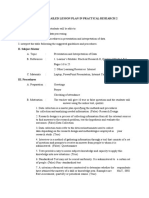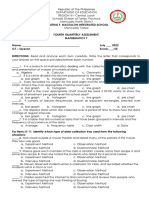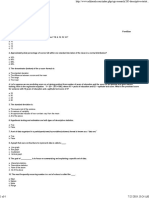LAS Q4 Week 4
LAS Q4 Week 4
Uploaded by
Yuan basCopyright:
Available Formats
LAS Q4 Week 4
LAS Q4 Week 4
Uploaded by
Yuan basOriginal Title
Copyright
Available Formats
Share this document
Did you find this document useful?
Is this content inappropriate?
Copyright:
Available Formats
LAS Q4 Week 4
LAS Q4 Week 4
Uploaded by
Yuan basCopyright:
Available Formats
NAGA CITY SCIENCE HIGH SCHOOL
LEARNING ACTIVITY SHEET
MATHEMATICS 7
Quarter 4
NAME DATE:
SECTION
VOCABULARY LIST
1. Ungrouped Frequency Distribution - displays the frequency of each
individual data value rather groups of data values. This type
of frequency distribution allows us to directly see how often
different values occurred in our data set.
2. Grouped Frequency Distribution - grouping the observations into intervals
and tabulating the frequencies for each interval. In
this distribution the intervals are called classes. The main
purpose of the grouped frequency table is to find out how
often each value occurred within each group of the entire data.
3. Relative Frequency Distribution - is the ratio (fraction or proportion) of the
number of times a value of the data occurs in the set of all
outcomes to the total number of outcomes.
4. Graph - a pictorial representation or a diagram that represents data or values in an
organized manner. The points on the graph often represent the
relationship between two or more things.
5. Bar graph - a chart that plots data using rectangular bars or columns (called bins)
that represent the total amount of observations in the data for
that category.
6. Line graph - a graph that uses lines to connect individual data points displaying
quantitative values over a specified time interval.
7. Pie graph - a type of graph in which a circle is divided into sectors that each
represent a proportion of the whole.
A. KNOWING
1. Below are Mathematics scores
of 18 students in their third
quarter examination.
Mathematics Scores
92, 88, 87, 90, 92, 89, 86, 83, 89,
86, 84, 88, 88, 92, 90, 90, 84, 92
2. Complete the frequency distribution
table the first one is done for you.
B. UNDERSTANDING
Directions: Read the statements below and choose the letter of your answer in each
item. Write your answer before the item number.
____1. Which among the types of graphs is useful in presenting data that indicate trends over a
period of time?
A. Bar Graph C. Line Graph
B. Histogram D. Pie Chart
____2. What graph is used for making direct visual comparison of data with spaces in between
bars?
A. Bar Graph C. Line Graph
B. Histogram D. Pie Chart
For questions 3 – 5, refer your answer in the illustration below.
Blue
25%
____3. What type of graph is represented in the illustration above?
A. Bar Graph C. Line Graph
B. Histogram D. Pie Chart
____4. What color is the most favored?
A. Green C. White
B. Red D. Yellow
____5. What percent of students chose red as their favorite color?
A. 15% C. 25%
B. 20% D. 30%
For questions 6 – 10, refer to the graph below.
____6. How many families have more than 3 children?
A. 4 B. 5 C. 8 D. 10
____7. How many families have no children?
A. 1 B. 2 C. 3 D. 4
____8. How many families were present with 4 and 5 children?
A. 3 B. 5 C. 8 D. 10
____9. How many families were present in the reunion?
A. 5 B. 6 C. 21 D. 25
____10. What is the total number of children in all of the families?
A. 15 B. 45 C. 52 D. 64
C. DOING
1. The table below shows a survey result of the daily allowance of 45 Grade 7
students.
2. Construct a pie chart, vertical bar graph and line graph showing the result of
this survey.
VERTICAL BAR GRAPH LINE GRAPH
PIE CHART
Legend:
You might also like
- COT 1 Lesson Plan Practical Research IIDocument7 pagesCOT 1 Lesson Plan Practical Research IIRomy Sales Grande Jr.No ratings yet
- Q4 Summative Test FinalDocument5 pagesQ4 Summative Test FinalJan Andrew FajardoNo ratings yet
- Quiz No. 2Document4 pagesQuiz No. 2Sheena RachelleNo ratings yet
- Q4 G7 Summative Test #2Document2 pagesQ4 G7 Summative Test #2Erica NuzaNo ratings yet
- Quarter-4-Exam MATH 7 FinalDocument4 pagesQuarter-4-Exam MATH 7 FinalVanessa Joy Saavedra100% (6)
- Grade 7 Exam Q4Document9 pagesGrade 7 Exam Q4mantilejoshua05No ratings yet
- Stats ExamDocument3 pagesStats Examjeffrey almozaraNo ratings yet
- Unit 4: An Overview On The Analysis and Interpretation of Assessment ResultsDocument18 pagesUnit 4: An Overview On The Analysis and Interpretation of Assessment ResultsFa MarieNo ratings yet
- 4th Exam Math7Document3 pages4th Exam Math7Hajj BornalesNo ratings yet
- Grade 7 Fourth Quarter ExamDocument5 pagesGrade 7 Fourth Quarter ExamFernandoGavinCautonNo ratings yet
- Q4 W1 2 W4 Summativetest G 7Document4 pagesQ4 W1 2 W4 Summativetest G 7Lawrence IluminNo ratings yet
- Sampaga High School 4 Quarterly Examination in Mathematics 7Document4 pagesSampaga High School 4 Quarterly Examination in Mathematics 7Row Garcia100% (3)
- Assignment 4Document3 pagesAssignment 4Netaji GandiNo ratings yet
- Math 7 4thDocument4 pagesMath 7 4thDONNA MAY ZUNIGA100% (4)
- Basic Statistics Test OneDocument3 pagesBasic Statistics Test OnegenanewNo ratings yet
- Adv StatDocument6 pagesAdv StatKaren Loremia TapecNo ratings yet
- LaaaDocument2 pagesLaaaRoeven NioscoNo ratings yet
- Math 7 q4 Week 4 5 Module 3 Organizing Data Using Graphs For ReproductionDocument22 pagesMath 7 q4 Week 4 5 Module 3 Organizing Data Using Graphs For ReproductionMary LourielleNo ratings yet
- Grade 7 Q4 Summative Test SY 2022-2023Document4 pagesGrade 7 Q4 Summative Test SY 2022-2023Pagalanggang NHS (R III - Bataan)No ratings yet
- LS-3-Math And-Prob Sol SkillsDocument11 pagesLS-3-Math And-Prob Sol SkillsJuvilla BatrinaNo ratings yet
- 4TH QUARTER EXAM - StudentsDocument3 pages4TH QUARTER EXAM - Studentsjoseph bundaNo ratings yet
- 3rd ASSESSMENT IN MATHEMATICS 7Document3 pages3rd ASSESSMENT IN MATHEMATICS 7Jaybie TejadaNo ratings yet
- Grade 7 Test ReviewerDocument5 pagesGrade 7 Test ReviewerMyra Ramirez RamosNo ratings yet
- Math 7 4th Grading Unit TestDocument3 pagesMath 7 4th Grading Unit TestRickrick EspinaNo ratings yet
- TAREA 2 Terminada ANA GIOVANNA BIOESTADISTICADocument6 pagesTAREA 2 Terminada ANA GIOVANNA BIOESTADISTICAAna GiovannaNo ratings yet
- North Luzon Philippines State College: Midterm Examination IN Ge 4 - Mathematics in The Modern WorldDocument8 pagesNorth Luzon Philippines State College: Midterm Examination IN Ge 4 - Mathematics in The Modern WorldMark Jether GasmenNo ratings yet
- Bus - Math Test (FINAL) 2nd DraftDocument3 pagesBus - Math Test (FINAL) 2nd DraftMarylyd tiuNo ratings yet
- Mnhs Mathematics 7 Quarter 4 ExamDocument4 pagesMnhs Mathematics 7 Quarter 4 ExamNORVEEN CAMPANILLANo ratings yet
- Summative Test in Math 7 4th QRTRDocument2 pagesSummative Test in Math 7 4th QRTRArlene Ocubillo SusonNo ratings yet
- 4th Periodical Test-G7 New 2023Document4 pages4th Periodical Test-G7 New 2023Loradel ElidaNo ratings yet
- Math 7 4TH Quarter TQDocument5 pagesMath 7 4TH Quarter TQrey som velardeNo ratings yet
- Practice Test in StatisticsDocument3 pagesPractice Test in StatisticsJoy Cabato Bayno100% (2)
- Statistical Analysis With Software Application: Module No. 2Document13 pagesStatistical Analysis With Software Application: Module No. 2Vanessa UbaNo ratings yet
- LESSON PLAN For DemoDocument3 pagesLESSON PLAN For DemoSul TanNo ratings yet
- Topic 5. Graphical Methods of Data RepresentationDocument6 pagesTopic 5. Graphical Methods of Data Representationyvonneisah02No ratings yet
- February 1, 2019Document3 pagesFebruary 1, 2019Veronica LopezNo ratings yet
- MATH 7 Q4 Module 3Document20 pagesMATH 7 Q4 Module 3Jen TarioNo ratings yet
- ExampleDocument11 pagesExampleDomilyn Arienza100% (1)
- ASSESSMENT IN LEARNING 1 - GROUP 8Document16 pagesASSESSMENT IN LEARNING 1 - GROUP 8Haydee Wenn DantesNo ratings yet
- QBSTS_C1Document27 pagesQBSTS_C1aritrasdg20No ratings yet
- 2nd Quarterly Exam in Practical Research 2 - 12Document3 pages2nd Quarterly Exam in Practical Research 2 - 12Vee Jay BlanciaNo ratings yet
- 2022 FM3 SEND Week 1Document12 pages2022 FM3 SEND Week 1jedisavage MinecraftNo ratings yet
- Descriptive StatisticsDocument4 pagesDescriptive StatisticsWonde ElecNo ratings yet
- Unit 8 Tutorial 01 Business ManagementDocument4 pagesUnit 8 Tutorial 01 Business ManagementNaufaNo ratings yet
- ANSWERS KEY (Removal)IN MIDTERM EXAM IN STATISTICS 2018-2019Document2 pagesANSWERS KEY (Removal)IN MIDTERM EXAM IN STATISTICS 2018-2019RODULFO V. PAQUINGANNo ratings yet
- Math Module Grade 7 - ExampleDocument26 pagesMath Module Grade 7 - ExampleFrankNo ratings yet
- week9-LS3 LAS (Pie Graph)Document16 pagesweek9-LS3 LAS (Pie Graph)jbprinterrepairNo ratings yet
- Fourth Quarter Test Mathematics 7Document3 pagesFourth Quarter Test Mathematics 7angelen buhaweNo ratings yet
- Complex Numbers, Probabilities, and StatisticsDocument5 pagesComplex Numbers, Probabilities, and Statisticskim sitonNo ratings yet
- PRELIM in Stat AnalDocument5 pagesPRELIM in Stat AnalAd DesignNo ratings yet
- Maeberlyn Lesson 5Document2 pagesMaeberlyn Lesson 5Christian John Resabal BiolNo ratings yet
- Mathematics: Quarter 4 - Module 6: Analysis and Interpretation of Statistical DataDocument28 pagesMathematics: Quarter 4 - Module 6: Analysis and Interpretation of Statistical DataHariette Denisse BarriosNo ratings yet
- Question Bank Converted 1Document33 pagesQuestion Bank Converted 1Huda GhaziNo ratings yet
- Summative TestDocument2 pagesSummative TestelleNo ratings yet
- Determine Whether Each Statement Is True or False. (Statistics)Document3 pagesDetermine Whether Each Statement Is True or False. (Statistics)Afshan Liaquat0% (1)
- Math7 Q4 Mod3Document30 pagesMath7 Q4 Mod3JAYNAROSE IBAYANNo ratings yet
- Q4Document9 pagesQ4Marie TuraNo ratings yet
- 1696603448-MDM4U - Unit 2 Statistical AnalysisDocument9 pages1696603448-MDM4U - Unit 2 Statistical Analysisrasmus05lindhNo ratings yet
- Long QuizDocument5 pagesLong QuizMaria Carmela Oriel MaligayaNo ratings yet



























































